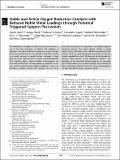Stable and Active Oxygen Reduction Catalysts with Reduced Noble Metal Loadings through Potential Triggered Support Passivation
Author(s)
Göhl, Daniel; Rueß, Holger; Schlicht, Stefanie; Vogel, Alexandra; Rohwerder, Michael; Mayrhofer, Karl JJ; Bachmann, Julien; Román-Leshkov, Yuriy; Schneider, Jochen M; Ledendecker, Marc; ... Show more Show less
DownloadPublished version (814.2Kb)
Publisher with Creative Commons License
Publisher with Creative Commons License
Creative Commons Attribution
Terms of use
Metadata
Show full item recordAbstract
© 2020 The Authors. Published by Wiley-VCH Verlag GmbH & Co. KGaA. The development of stable, cost-efficient and active materials is one of the main challenges in catalysis. The utilization of platinum in the electroreduction of oxygen is a salient example where the development of new material combinations has led to a drastic increase in specific activity compared to bare platinum. These material classes comprise nanostructured thin films, platinum alloys, shape-controlled nanostructures and core–shell architectures. Excessive platinum substitution, however, leads to structural and catalytic instabilities. Herein, we introduce a catalyst concept that comprises the use of an atomically thin platinum film deposited on a potential-triggered passivating support. The model catalyst exhibits an equal specific activity with higher atom utilization compared to bulk platinum. By using potential-triggered passivation of titanium carbide, irregularities in the Pt film heal out via the formation of insoluble oxide species at the solid/liquid interface. The adaptation of the described catalyst design to the nanoscale and to high-surface-area structures highlight the potential for stable, passivating catalyst systems for various electrocatalytic reactions such as the oxygen reduction reaction.
Date issued
2020Department
Massachusetts Institute of Technology. Department of Chemical EngineeringJournal
ChemElectroChem
Publisher
Wiley